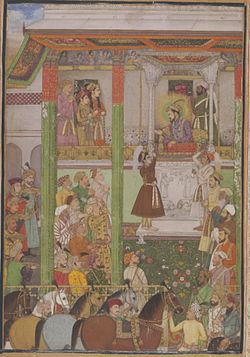Ali Mardan Khan
Thank you for being part of the Bharatpedia family! 0% transparency: ₹0 raised out of ₹100,000 (0 supporter) |
Ali Mardan Khan (Persian: علی مردان خان, Urdu: علی مردان خان) (died April 1657[1]) was a Kurdish[2] military leader and administrator, serving under the Safavid kings Shah Abbas I and Shah Safi, and later the Mughal ruler Shah Jahan. He was the son of Ganj Ali Khan. After surrendering the city of Qandahar, part of the easternmost territories of the Safavids to the Mughals in 1638, he served with distinction in the Mughal administration, earning the highest honors of the Mughal court.
Biography[edit]


Ali Mardan Khan was the Safavid governor of Qandahar. He had been in arrears with his revenues. He was summoned by Shah Tahmasp to appear at the court, but avoided doing so. On being dismissed from office, he sought the assistance from the governor of Kabul and the commander of Ghazni. In 1638, he surrendered Qandahar to the Mughals, and took refuge in Delhi. He was honoured at the Mughal court. Shah Jahan gifted one lakh of tankas for himself and two lakhs for the officers of his army. He was appointed governor of Kashmir, Kabul[3] and Punjab.
He later received the title of Amir al-Umara (Lord of Lords) in 1639 and became a Haft Hazari, leading to commanding an army of 7,000 troops.
He was later appointed as the viceroy of Punjab which at that time stretched from Kabul to Delhi.
There is a locality named after him "Bagh-e-Ali Mardan Khan" in Srinagar, Jammu & Kashmir.
References[edit]
- ↑ Tomb of Ali Mardan Khan
- ↑ J.J.L. Gommans, "Mughal Warfare: Indian Frontiers and Highroads to Empire 1500–1700" one year after the Kurdish turncoat Ali Mardan Khan had handed Qandahar
- Rajmohan Gandhi, "Punjab: A History from Aurangzeb to Mountbatten" Shah Jahan's chief engineer for such projects was a Kurdish general, Ali Mardan Khan Archived 22 December 2015 at the Wayback Machine
- Clifford Edmund Bosworth, E. Van Donzel, B. Lewis, The Encyclopaedia of Islam: Supplement : "Fascicules 1-2", pg. 63 - ↑ Majumdar, R.C. (ed.) (2007). The Mughul Empire, Mumbai: Bharatiya Vidya Bhavan, ISBN 81-7276-407-1, p.204
- Mahajan, V.D. (1991, reprint 2007). History of Medieval India, Part II, ISBN 81-219-0364-5, p.144
External links[edit]
- Pages with listed invalid ISBNs
- Articles containing Persian-language text
- Year of birth missing
- 1657 deaths
- Mughal nobility
- Subahdars of Lahore
- Subahdars of Kashmir
- 17th-century soldiers
- Safavid governors of Qandahar
- Iranian emigrants to the Mughal Empire
- 17th-century people of Safavid Iran
- Iranian Kurdish people


